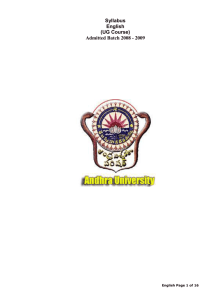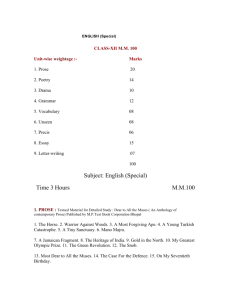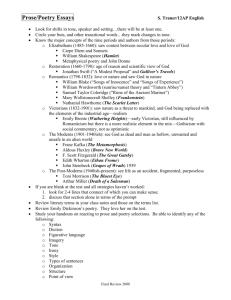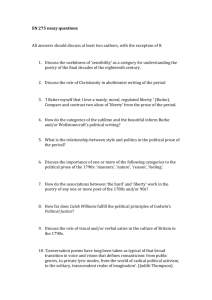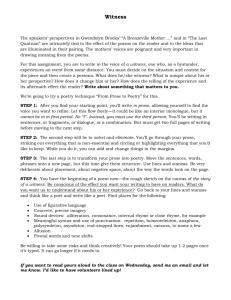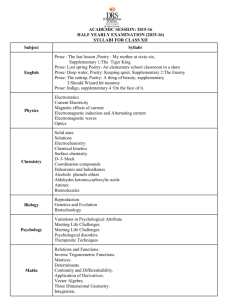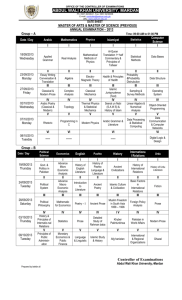Syllabus English (UG Course) Admitted Batch 2008
advertisement
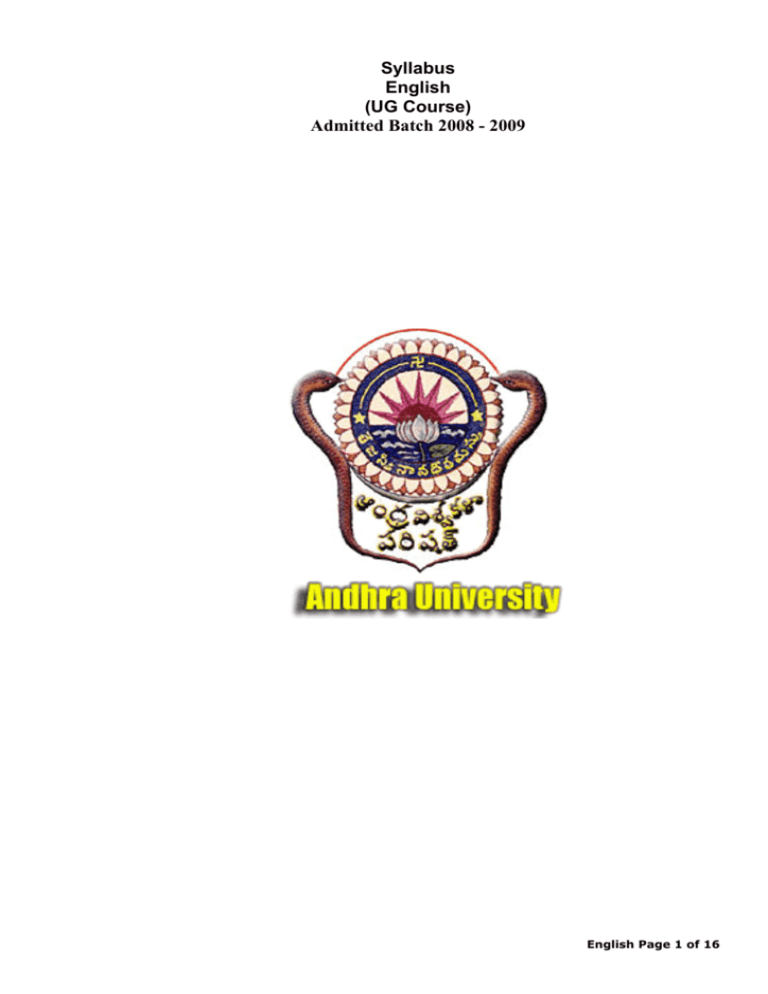
Syllabus English (UG Course) Admitted Batch 2008 - 2009 English Page 1 of 16 MEETING OF THE SUBJECT COMMITTEE IN ENGLISH DEPARTMENT OF ENGLISH, S. V. UNIVERSITY, TIRUPATI – 517501 Members Present: 1. Prof. C. R. Visweswara Rao 2. Prof. G. Damodar 3. Prof. V. C. Sudheer 4. Prof. G. M. Sundara Valli 5. Dr. P. Rajasekhar 6. Dr. B. Varalakshmi 7. Dr. Sarah Hithavachani 8. Dr. M. Sarat Babu 9. Prof. M. Narendra, Coordinator The Committee met in the Rector’s chambers at Sri Venkateswara University, Tirupati on 28th and 29th April 2008 to identify the texts to be prescribed for each of the three papers, Prose, Poetry, Further Reading and Communication Curriculum for the First, Second and Third Year Degree Courses as a follow-up of the curriculum arrived at in its first meeting held on 26th and 27th March 2008. The publishers placed before the Committee a number of anthologies prepared and published by them. The Committee went carefully through the material presented and evaluated it in terms of the curricular requirements already arrived at. Taking into consideration the requirements of the undergraduate classroom, a choice of texts was identified in terms of the imparting of the humanistic values and teaching of language with a focus on the development of communication and employable skills in the students. In this process, the Committee resolved to dispense with literary history and chronology and make the study of the students as wide ranging as possible within the ambit of world writing. 1. When the publisher is chosen, he has to conform to the prescription of the various grammatical, language, communication, pre-reading, while-reading, postreading components, exercises and tasks as already communicated to the APSCHE by the Committee in its resolutions at the meeting on 26th and 27th March 2008. English Page 2 of 16 2. The Committee was of the opinion that when the publisher is finally chosen, the task of working out its conception of the textbook needs to be overseen preferably by the Committee. Further when the publisher completes the task of complying with the requirements of the Committee, the completed textbook, before it is brought out, will have to be gone through and approved by the Committee. 3. The Committee further suggests that as an optional item, a CD be offered by the publisher as a Reading and Listening Supplement to the Textbook. 4. Since every textbook consists of exercises of various kinds, the Committee is of the opinion that a key has to be supplied at the end of it. And also every textbook must provide a map of the book at the beginning. 5. A further recommendation of the Committee is that the publisher must so ensure that without compromising on the quality of production, the price has to be reasonable and within the reach of the student, not exceeding the price of the Prose and Poetry Selections of the previous syllabus. 6. The Committee is deeply engaged with the question of the transaction of the syllabus in the classroom and it suggests that a Teacher’s Manual may also be brought as a separately priced item. After a careful exercise in selection, the committee found that from among the published anthologies presented for scrutiny by Macmillan India Limited, the following items have been identified for possible prescription for the First Year Prose and Poetry. The conditions mentioned in paragraphs 1 to 6 apply to the Textbook to be brought out if this publisher is authorized to do. English Page 3 of 16 FIRST YEAR POETRY Title of the Poem 1. Ode to Autumn 2. Dover Beach 3. The Unknown Citizen 4. Insensibility 5. Poem – 36 6. Home Coming 7. Myriad-Winged Bird 8. Telephone Conversation PROSE Title of the Prose Lesson 1. Spoken English and Broken English 2. Is Progress Real? 3. Stephen Leacock 4. The Best Investment I Ever Made 5. Prospects of Democracy 6. I Have a Dream 7. Letter to a Teacher 8. Message and Medium Name of the Poet John Keats Matthew Arnold W. H. Auden Wilfred Owen Rabindranath Tagore Parthasararhy A. Satyavathi Devi Wole Soyinka Name of the Author G. B. Shaw Will Durant Conjuror’s Revenge A. J. Cronin Dr. B. R. Ambedkar Martin Luther King Nora Rossi and Tom Cole Times of India Nov 27, 1996 GRAMMAR AND VOCABULARY 1. Reading Comprehension 2. Verb Forms 3. Right Words (Synonyms, Antonyms, Homonyms and One-Word Substitutes) 4. Idioms 5. Detection of Errors The Committee identified the following lessons for possible prescription from among the published anthologies placed before it by Orient Longman Private Limited. The conditions mentioned in paragraphs 1 to 6 apply to the Textbook to be brought out if this publisher is authorized to do. English Page 4 of 16 SECOND YEAR POETRY Title of the Poem 1. The Sunne Rising 2. The Solitary Reaper 3. Road Not Taken 4. Refugee Mother and Child 5. Good Bye Party for Mrs. Pushpa T. S. 6. I will embrace only the sun Post-Modern Telugu Poetry, OUP ) PROSE Title of the Prose Lesson 1. Film-Making 2. Not Just Oranges 3. Talk on Advertising 4. On Shaking Hands 5. Indian Contribution to World Unity 6. Decolonizing the Mind Name of the Poet John Donne William Wordsworth Robert Frost Chinua Achebe Nissim Ezekiel Tripuraneni Srinivas (Down to Earth, Name of the Author Satyajit Ray Premchand Herman Wouk A. G. Gardiner Toynbee Ngugi wa Thiong’o COMPOSITION AND GRAMMAR 1. Resume Writing/e-Correspondence 2. Note-Making/ Mind Mapping 3. Expansion of Proverbs and Ideas/ Information Transfer 4. Description of Pictures/ Report Writing of a dialogue (from One-Act Plays) The Committee identified the following lessons for possible prescription from among published anthologies placed before it by Maruthi Publications, Guntur. The conditions mentioned in paragraphs 1 to 6 apply to the Textbook to be brought out if this publisher is authorized to do. There is no need to bring out any CD as a supplement to the textbook. English Page 5 of 16 FURTHER READING FOR FIRST YEAR The plan of the Text and the Exercises as per the Annexure – 2 Short Stories: 1. How Far is the River 2. The Last Clock 3. Little Girls are wiser than Men One-Act Plays 1. Sacrifice (The Last Act only) 2. The Boy Comes Home 3. Merchant of Venice (Casket Scene only) Ruskin Bond James Thurber Leo Tolstoy Rabindranath Tagore A. A. Milne William Shakespeare LANGUAGE USAGE 1. Punctuation (to be given from a one-act play) 2. Dialogue Writing (to be given from a short story) English Page 6 of 16 The Committee identified the following lessons for possible prescription from among published anthologies placed before it by Lorven Publications, Hyderabad. The conditions mentioned in paragraphs 1 to 6 apply to the Textbook to be brought out if this publisher is authorized to do. There is no need to bring out any CD as a supplement to the textbook. FURTHER READING FOR SECOND YEAR Short Stories: 1. Gajar Halwa Gita Hariharan 2. My Brother, My Brother Norah Burke 3. The Man on the Road M. Rajaram (from Indian Literature, 166 Mar-Apr 1995, Vol XXXVIII, No: 2, Sahitya Academy) One-Act Plays 1. Never-Never Nest Cedric Mount 2. Refund Ritz Karinthi 3. Julius Caesar (Caesar’s Murder Scene only) William Shakespeare INFORMATION TRANSFER, COMMUNICATION AND COMPOSITION 1. Jumbled Passages (from one-act plays) 2. Paragraph-Writing (with hints from short stories) English Page 7 of 16 The books by Macmillan and Orient Longman come close to the following topics meant for the third year syllabus. The conditions mentioned in paragraphs 1 to 6 apply to the Textbook to be brought out if this publisher is authorized to do. THIRD YEAR COMMUNICATION CURRICULUM Macmillan 1. Communication – Verbal and Non-Verbal 2. Spoken English with Group Discussion and Debates 3. Business Writing (types of CVs with Covering Letters) 4. e-Mail Writing (with principles) 5. News-Reading (compeering/anchoring ) Orient Longman 1. Presentation Skills 2. Facing an Interview (with Mock Role-Plays) 3. Listening Skills (for mood, tone, attitude) 4. Telephone Skills (listening/responding/initiating) English Page 8 of 16 I year Degree English syllabus and pattern commencing from the academic year 2008-’09 6 Hours per week PROSE : 6 Lessons 10 Marks POETRY : 6 Poems 10 Marks ADDITIONAL READING/FURTHER READING: 2 Short Stories & 2 One-Act Plays 10 Marks ( Non-detailed Text ) COMPOSITION & GRAMMAR : 20 Marks PRACTICAL EXAMINATION : 50 Marks : Record Work : Computer based examination 1 Hour 10 Marks 40 Marks Practical Examination Syllabus & Model Paper will be on the model of the previous years. No change is made in the existing practical syllabus. SUGGESTED SYLLABUS POETRY: Title of the Poem Name of the Poet 1. Ode to Autumn 2. Dover Beach 3. The Unknown Citizen 4. Home Coming 5. Myriad – Winged Bird 6. Telephone Conversation John Keats Mathew Arnold W. H. Auden Parthasarathy A. Satyavathi Devi Wole Soyinka PROSE: Title of the Prose Lesson Name of the Author 1. Spoken English and Broken English 2. Conjuror’s Revenge 3. Prospects of Democracy G.B. Shaw Stephen Leacock Dr.B.R. Ambedkar English Page 9 of 16 4. I Have a Dream 5. Letter to a Teacher 6. Message and Medium Martin Luther King Nora Rossi and Tom Cole Times of India Nov 27, 1996 ADDITIONAL READING: Short Stories: 1. How Far is the River 2. Little Girls are wiser than Men Ruskin Bond Leo Tolstoy One-Act Plays: 1. Sacrifice (The Last Act only) 2. Merchant of Venice (Casket Scene only) Rabindranath Tagore William Shakespeare GRAMMAR AND VOCABULARY: 1. 2. 3. 4. Comprehension (Unseen Passage) Verb Forms Right Words (Synonyms, Antonyms, Homonyms and One-Word Substitutes) Correction of Errors PART – II: ENGLISH PAPER – I Modifications Made; Paper – 1 “Ode to a Skylark” instead of “Ode to the West Wind” by P.B. Shelley There is no change in the model question paper. English Page 10 of 16 MODEL QUESTION PAPER FOR B. A., B. Sc., & B. Com., I Year ENGLISH 2008-’09 Duration: 2 Hours 1. Prose: 10 Marks (Section – A) 2. Additional Reading (Non-Detailed Text): 10 Marks (Section-C) 3. Reading Comprehension, Grammar & Vocabulary: 20 Marks (Section-D) Section – A I. Answer any TWO out of FOUR following in about 50 words 2 x 5 = 10 Section – B II. Answer any TWO out of FOUR following in about 50 words 2 x 5 = 10 Section – C III. Answer any TWO out of FOUR following in about 50 words 2 x 5 = 10 Section – D IV. Reading Comprehension (An unseen passage of about 200 words): (Questions: 2 on facts, 1 on inference, 1 on vocabulary and 1 on grammar) 5 x 1 = 5 V. Fill in the blanks with suitable verb forms: 5 VI. Multiple choice questions on words (Synonyms: 2, antonyms: 2, one-word substitutes:1) 5 VII. Correction of errors: 5 English Page 11 of 16 Annexure – 1 MODEL CURRICULUM IN ENGLISH Objectives: 1. To expose the learners to cultural diversity and value education through the humanistic curriculum 2. To empower the learners with skills necessary for global placements 3. To equip the learners with the skills essential for their academic subjects 4. To acquaint the learners with reference skills 5. To encourage learner autonomy through pair and group activities 6. To help the learners and the facilitator visualize the theoretical and practical components of the course as a complement to each other 7. To encourage the facilitator to make creative use of various pedagogical tools and the new educational technology 8. To orient the learners to utilize the fruits of the ICT Revolution for equipping themselves for international competitive examinations Expected Outcomes: Keeping in view the recommendations of APSCHE and the National Knowledge Commission, the expected outcomes 1. For the learners are that they will be able: i) To be aware of cultural diversity and values of life ii) To communicate effectively with coherence and relevance in speech and writing iii) To be proficient with the Soft Skills required for global placements iv) To participate in brainstorming sessions for cooperative learning v) To be proficient in modes of web-based learning 2. For the teachers are that i) There will be a growing awareness of their role as facilitators ii) They will be progressive use of interactive teaching technologies iii) There will be a greater recognition of the role of leaner–centric approach English Page 12 of 16 Annexure – 2 FIRST YEAR SYLLABUS Textbooks planned: 1. Prose, Poetry, Grammar & Communicative Functions 2. Non-Detailed Text and Composition Lessons planned: Prose: 6 Poetry: 6 Non-detailed Text: 4 (2 Short Stories & 2 One-Act Plays) Prose: Indian: 2 African: 1 American: 1 British: 2 [Philosophy / Religion Biography/Autobiography Science & Environment Humour & Irony Cultural Issues Literary Sketch / Real Life Story] Poetry: Indian: 2 African: 1 American: 1 British: 2 Non-detailed Textbook: Stories: 1 Indian & 1 English One-Act Plays: 1 Indian & 1 English The Plan of the Text and the Exercises: 1. Pre-Reading Activities: 2 (1 on the theme and 1 on the vocabulary of the lesson) a. Questions on background knowledge/prediction about the theme (e.g: What do you know / want to know about the lesson before you read it? Can you guess what it is about?) English Page 13 of 16 b. Questions to elicit the words essential to the lesson (What ideas and words do you get about the lesson? e.g: If it is a bank, what things and activities do find there?) 2. The Text of the Lesson (Relevant pictures wherever possible) 3. Glossary with pronunciation Guide (synonyms, antonyms and homonyms may be given) 4. While-Reading Activities: a. 12 one word/sentence answer questions for listening and answering (The teacher reads each paragraph and asks these questions) b. 10 multiple choice questions on specific details and inferences c. 4 to 8 short answer questions and d. 3 to 5 long answer questions 5. Post-Reading Activities: a. 2 to 3 Tasks on Information Transfer: drawing pictures/making posters /tree diagrams/note-making/ mind-mapping related to the lesson b. Group Discussion about the interesting topics taken from life/current events related to the lesson. c. Role-Play of the characters from the lesson/Casting the story (Identifying film actors to play the roles given in the story if it is one). d. Arguments different to the one in the lesson / different ending of the story / debates about the topics in the lesson/Preference line. e. Comparison with the similar essay/story/poem from Telugu. 6. Language Development Activities: a. Pronunciation: Exercise on the problem sounds such as /v/ and /w/ (Examples can be taken from the lesson). b. Match the following on essential words/phrases and idioms from the lesson (8/12). c. Exercise on a passage with blanks to be filled in by synonyms /antonyms /homonyms taken from the text. d. Substitution (Re-read/rewrite a paragraph from the lesson or outside, using a different tense/personal pronoun. e.g: Past Tense in place of Present Tense; “I” in place of “(s)he” and so on. e. Fill in the blanks with suitable articles/prepositions/adjectives/conjunctions/ verb forms (A contextualized paragraph with 10 or more blanks). f. Correction of common errors (Nouns/Determiners/Verbs/Prepositions/ Conjunctions/Adverbs: one for each lesson) (10 to 20 questions) g. Four tasks on putting jumbled sentences in proper order to make a meaningful paragraph. (All these are to be task-based activities which involve pair & group activities and cooperative learning) English Page 14 of 16 Annexure – 4 SECOND YEAR SYLLABUS Textbooks planned: 1. Prose, Poetry, Grammar & Communicative Functions 2. Non-Detailed Text and Composition Lessons planned: Prose: 6 Poetry: 6 Non-detailed Text: 4 (2 Short Stories & 2 One-Act Plays) Prose: Indian: 2 African: 1 American: 1 British: 2 [Philosophy / Religion Biography/Autobiography Science & Environment Humour & Irony Cultural Issues Literary Sketch / Real Life Story] Poetry: Indian: 2 African: 1 American: 1 British: 2 Non-detailed Textbook: Stories: 1 Indian & 1 English One-Act Plays: 1 Indian & 1 English The Plan of the Text and the Exercises: 1. Pre-Reading Activities: 2 (1 on the theme and 1 on the vocabulary of the lesson) a. Questions on background knowledge/prediction about the theme b. (e.g: What do you know / want to know about the lesson before you read it? Can you guess what it is about?) c. Questions to elicit the words essential to the lesson (What ideas and words do you get about the lesson? e.g: If it is a bank, what things and activities do find there?) English Page 15 of 16 2. The Text of the Lesson (Relevant pictures wherever possible) 3. Glossary with pronunciation Guide (synonyms, antonyms and homonyms may be given) 4. While-Reading Activities: a. 12 one word/sentence answer questions for listening and answering (The teacher reads each paragraph and asks these questions) b. 10 multiple choice questions on specific details and inferences c. 4 to 8 short answer questions and d. 3 to 5 long answer questions 5. Post-Reading Activities: a. 2 to 3 Tasks on Information Transfer: drawing pictures/making posters /tree diagrams/note-making/ mind-mapping related to the lesson b. Summarizing the lesson with the help of notes made in the previous exercise. c. Group Discussion about the interesting topics taken from life/current events related to the lesson. d. Interviews with the character/ author (Group work: one student pretends to be the character/author of the lesson while others interview him/her). e. Writing letters to a character/the author of the lesson. f. Preparing Resume of a character/the author of the lesson. g. Arguments different to the one in the lesson / different ending of the story / debates about the topics in the lesson/Preference line. h. Comparison with the similar essay/story/poem from Telugu. 6. Language Development Activities: a. Pronunciation: Exercise on the problems of stress and intonation (Examples can be taken from the lesson) b. Match the following on one word substitutes from the lesson (8/12). c. Exercise on a contextualized passage with blanks to be filled in with one word substitutes taken from outside the text. d. Preparing a draft for a small speech about the topics related directly or indirectly to the lesson (Group work). e. Putting jumbled sentences/small paragraphs in an order (Group work). f. Preparing a resume for oneself and a cover letter to accompany it (Group work) in response to an advertisement taken from the newspaper (a model resume is given in the first lesson). g. Telephonic conversation about various personal and impersonal topics (Pair work). (All these are to be task-based activities which involve pair & group activities and cooperative learning) English Page 16 of 16

